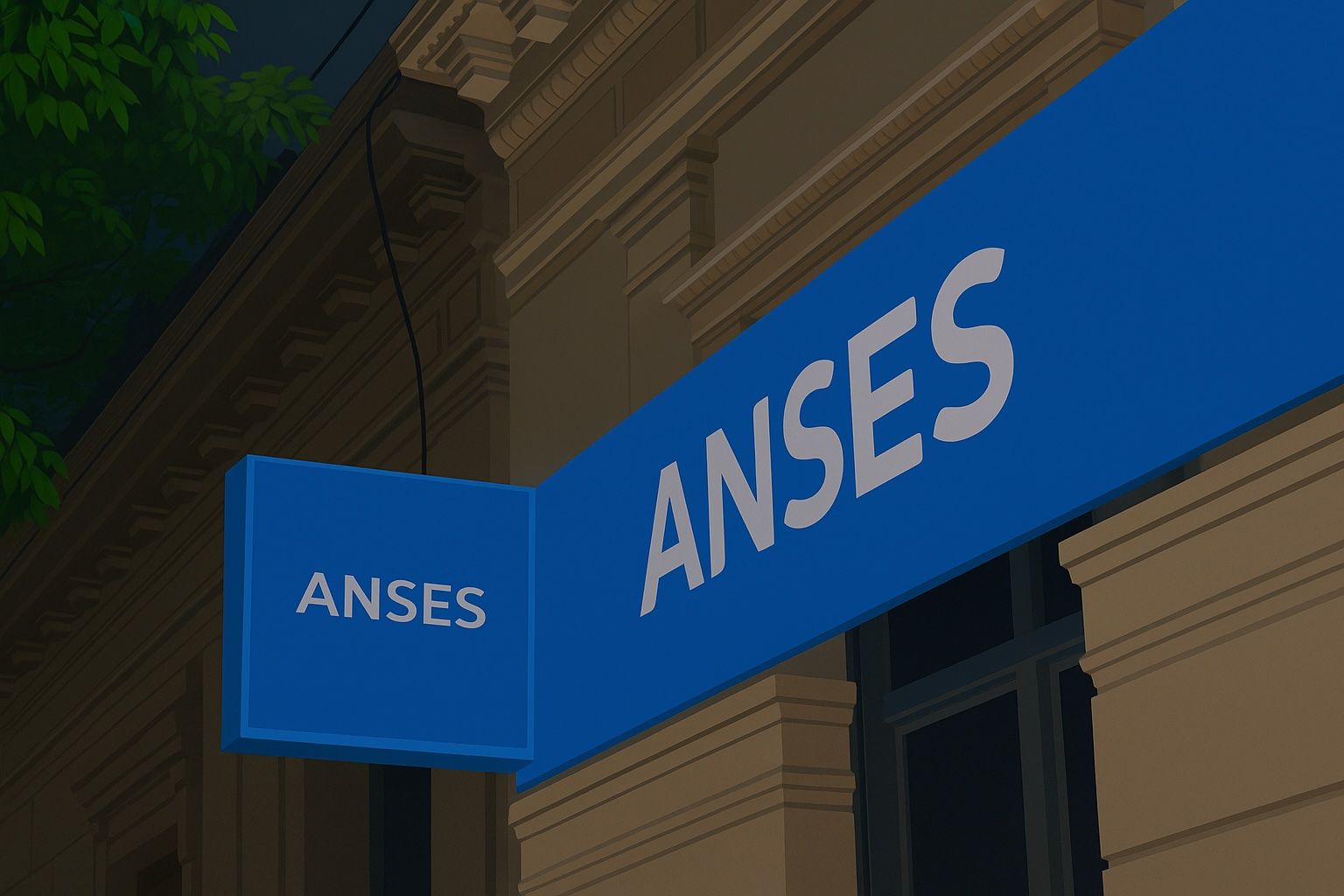- Adjusted Payment Schedule: ANSES (Argentina’s social security agency) released the full November 2025 payment calendar for pensions and social benefits, with dates pushed around an extra-long holiday weekend. No payments will occur on Friday Nov. 21 or Monday Nov. 24 due to national holidays, so some beneficiaries (like those with ID ending in 9) get paid early on Nov. 20 to avoid delays [1] [2]. Most payments kick off on Nov. 10 and wrap up by Nov. 28 under the revised timeline.
- Inflation-Indexed Benefit Increase:All ANSES benefits rise 2.1% in November, mirroring September’s inflation rate [3]. This monthly mobility adjustment, established by a 2024 decree, ensures vulnerable groups don’t lose purchasing power amid price increases [4]. The minimum pension now totals ARS 403,150 (including a ARS 70,000 supplemental bonus that continues unchanged) [5] [6]. Other pensions and allowances also got modest raises in line with inflation.
- Higher Payout Amounts: With the increase, pensioners on minimum benefits receive ARS 333,150 base pension plus a ARS 70,000 bonus (still in effect) – totaling ARS 403,150 this month [7]. The Universal Child Allowance (AUH) is now ARS 119,714 per child, though 20% is withheld until year-end paperwork, so about ARS 95,772 is paid monthly [8]. A family with three children on AUH also gets a food card (Tarjeta Alimentar) of ARS 108,062 – pushing their total aid above $100,000 [9]. (Notably, the food card amounts remain frozen at last year’s levels despite inflation [10].) Other programs like unemployment insurance and the “Volver al Trabajo” workfare plan provide set payments (e.g. ~ARS 78,000 for November) to eligible individuals [11].
- Stock Market Soars to Record Highs: Argentina’s stock market went on an October tear, with the S&P Merval index surging over 44% in one week at month’s end [12]. Post-election euphoria and a stable peso sparked a buying frenzy – the Merval hit ~3,000,000 points (a new nominal record) and even surpassed 2,000 points in U.S. dollar terms [13]. Several Argentine stocks skyrocketed: for example, Banco Supervielle jumped 149% in October, and blue-chip shares like Banco Macro, Grupo Galicia and power company Edenor all more than doubled [14]. Even Argentine bonds rallied up to 40%, while country risk (EMBI) plunged below 700, its lowest in 9 months [15].
- Cautious Optimism Ahead:Experts believe the market upswing could continue if economic reforms stay on track, but they warn it’s not guaranteed. “Continúa el optimismo en el mercado local tras la fuerte suba post-elecciones,” noted analyst Milo Farro – optimism remains high after the election-fueled jump [16]. Looking forward, “if currency and monetary issues are brought under control, the medium-term trend could be very favorable,” said Juan Manuel Franco, chief economist at SBS Group, emphasizing that accumulating genuine dollar reserves will be critical to sustain investor confidence [17]. Analysts highlight that Argentina’s yield curve has turned positive again and even suggest the country might gradually regain access to international credit by 2026 if this momentum continues [18]. However, they also caution that any policy missteps or political infighting could quickly erode the newfound market optimism [19].
ANSES Confirms November 2025 Payment Dates (Holiday Adjustments Included)
Argentina’s social security agency ANSES has published its complete payment schedule for November 2025, covering pensions, family allowances, and other social benefits [20] [21]. The calendar is organized, as always, by the last digit of beneficiaries’ DNI (ID), but this month it required special tweaks due to two public holidays in the third week of November [22]. The government declared Friday Nov. 21 a “feriado puente” (bridge holiday) and Monday Nov. 24 a national holiday for Sovereignty Day [23], creating a four-day weekend with no ANSES payments. As a result, ANSES reconfigured the payout dates to ensure no one’s payment is unduly delayed by the long break.
Most November payments will begin on Monday, Nov. 10 – a bit later in the month than usual. No payments are scheduled for Nov. 1–9, likely to accommodate the new monthly adjustment (and perhaps the tail end of October’s cycle). Starting the 10th, payments roll out in DNI order on business days, but skip the 21st and 24th entirely [24]. To compensate, some days will cover two ID terminations at once. Notably, beneficiaries whose IDs end in 9 will get paid early – on Nov. 20 – alongside those ending in 8, instead of waiting until after the long weekend [25]. This applies to vulnerable groups like pensioners receiving minimum pensions, so they aren’t left waiting extra days for their money. “Los jubilados cuyo DNI termina en 9 cobrarán el mismo día que aquellos con documento finalizado en 8,” ANSES confirmed – i.e. both 8 and 9 will be paid on Nov. 20 [26].
Here’s how the adjusted schedule breaks down for key programs (according to ANSES’s official calendar):
- Non-contributory pensions (PNC) – Paid Nov. 10–14. For example, DNI ending in 0–1 on Nov. 10, 2–3 on Nov. 11, and so on up to 8–9 on Nov. 14 [27]. These PNC benefits (for disability, old age, or mothers of 7+) are always first in the month, and November is no exception – albeit starting the 10th.
- Jubilaciones y Pensiones (Contributory Retirement and Pension) up to the minimum amount – Paid Nov. 10–20. DNI ending in 0 gets paid Nov. 10, 1 on Nov. 11… 7 on Nov. 19, then 8 and 9 together on Nov. 20 [28] [29]. This compressed timeline ensures all minimum pensions are disbursed before the Friday/Monday closure.
- Higher-value Pensions (above minimum) – Paid after the long weekend, from Nov. 21–28. DNI ending in 0–1 will only be able to collect starting Thurs. Nov. 21 (right before the holiday break) [30]. Then there’s a pause, and DNI 2–3 get paid on Tue. Nov. 25, 4–5 on Wed. Nov. 26, 6–7 on Thu. Nov. 27, and 8–9 on Fri. Nov. 28 [31]. In effect, the above-minimum pensions start a bit later than usual and finish at month’s end due to the mid-month holidays.
- AUH (Universal Child Allowance) and SUAF (formal sector family allowance) – Paid Nov. 10–20. These follow a similar pattern to the minimum pensions. DNI 0 through 7 are paid on Nov. 10, 11, … 17, 18, 19 respectively; DNI 8 and 9 both on Nov. 20 [32] [33]. (Initially, some sources indicated AUH ending in 9 might go on Nov. 25 [34], but ANSES later confirmed it moved up to Nov. 20 as well, aligning with the general schedule adjustments.) AUE (Pregnancy Allowance) dates mirror AUH, since it’s essentially the same program for expectant mothers [35].
- Unemployment Insurance (Prestación por Desempleo) – Paid Nov. 20–28. Because this benefit usually pays later in the month, the first installment (DNI 0–1) was pulled forward to Nov. 20 (instead of the 21st) [36]. The remaining DNI 2–9 are then staggered after the weekend, between Nov. 25 and 28 [37], in parallel with the higher pension schedule.
Other infrequent payments have their own windows: for example, Asignaciones de Pago Único (one-time marriage, birth or adoption grants) will be paid in a broad window from Nov. 12 to Dec. 10 for all DNI [38]. Similarly, family allowances for PNC are available Nov. 10 to Dec. 10 [39]. These extended windows mean recipients can claim those funds anytime in that period.
How to Check Your Date: ANSES reminds beneficiaries that they can verify their exact payment date and location online. By logging into the Mi ANSES portal with your CUIL, or using the ANSES website’s “Cuándo y Dónde Cobro” tool, you can input your benefit type and ID number to see your personalized schedule [40] [41]. The system will show the start date and the final date by which you can collect. This is handy if you’re unsure or if you miss the initial payout day – typically, you have until about 5–10 business days after to withdraw the money.
In summary, November’s payment calendar is a bit unusual – front-loaded from the 10th and avoiding the 21st–24th break. ANSES explicitly planned these adjustments “para evitar demoras en los pagos por el fin de semana largo” – to prevent delays due to the long weekend [42]. If you’re a beneficiary, mark your date (it may be earlier than normal if your DNI is 9!), and remember that banks and ATMs won’t process ANSES benefits on the holiday Friday or Monday. Normal payment operations resume on Tuesday, Nov. 25 for those still awaiting their turn.
2.1% Benefit Hike to Keep Up with Inflation (New Minimums and Bonuses)
November brings a pay bump for all ANSES beneficiaries – albeit a small one. The government applied a 2.1% increase to pensions and social assistance checks this month [43] [44]. This figure isn’t random: it matches the official inflation rate for September 2025, which was 2.1% [45]. In fact, a new indexation rule (Decree 271/2024) pegs monthly benefit adjustments to the inflation data from two months prior [46] [47]. Since inflation has cooled dramatically in Argentina (down to low single digits monthly), authorities shifted to monthly tweaks (instead of the old quarterly mobility formula) to more closely protect purchasing power. Esta medida responde a lo que establece el Decreto 271/2024 sobre aumentos por movilidad, para que los sectores más vulnerables no pierdan poder adquisitivo frente al aumento de precios [48] – in other words, it’s meant to ensure pensions and allowances keep up with rising prices, preventing real income erosion for society’s most vulnerable.
The result: November 2025 payments are 2.1% higher than October’s across the board [49]. While 2% may sound modest, it’s a reflection of Argentina’s newly subdued inflation – reportedly just over 2% again in October [50], a far cry from the double-digit monthly spikes seen in previous years. Thanks to this stability, the cumulative increase for 2025’s final quarter is relatively small. But many retirees are also benefiting from a generous fixed bonus that the government has extended.
The ARS 70,000 Extraordinary Bonus: All pensioners on the minimum retirement (and certain PNC pensioners) continue to receive a flat $70,000 supplemental bonus on top of their calculated benefit [51]. This bonus was introduced as temporary relief during high inflation and has been repeatedly renewed. It remains unchanged in November (no increase), which means its relative value is gradually eroding with inflation – but it still provides a significant boost to those at the bottom. ANSES confirmed the “continuidad del bono extraordinario de $70.000” for November [52].
Thanks to the latest raise plus the ongoing bonus, here are the updated ANSES payout amounts for November 2025:
- Minimum state pension:ARS 403,150.65 total (up from about ARS 395,000 last month). This is composed of a base pension ARS 333,150.65 plus the ARS 70,000 bonus [53]. Example: A retired worker receiving the minimum will see roughly ARS 8,200 more this month than in October – a 2.1% increase on the base, while the bonus stays at a flat 70k.
- Maximum pension:ARS 2,241,129.34 (no bonus applicable at the top end) [54]. Argentina caps its public pensions at this amount post-increase.
- PUAM (Universal Pension for Seniors 65+ without full contributions):ARS 336,520.52 total = ARS 266,520.52 base + ARS 70,000 bonus [55]. PUAM is set at 80% of the minimum pension by law, and recipients also get the full bonus.
- Non-contributory Pension (Disability or Old-Age):ARS 303,205.46 total = ARS 233,205.46 base + ARS 70,000 bonus [56]. These pensions (for those who never contributed formally) are 70% of the minimum, but the government tops them up with the same bonus amount.
- Non-contributory Pension for Mothers of 7+ children:ARS 403,150.65 (equivalent to the minimum pension + bonus) [57]. By policy, mothers of large families receive a pension equal to the minimum; with the bonus, they effectively get the same ARS 403k as other minimum pensioners.
These adjusted amounts take effect in November [58]. Beneficiaries will notice the slight bump in their payments mid-month. While a 2.1% raise may barely exceed a single month’s inflation, it is part of an ongoing strategy of monthly indexation. In fact, ANSES is expected to announce another increase for December based on October’s CPI data (likely in the 2% range again). If Argentina’s disinflation trend continues, the real value of pensions could finally stop falling and even stabilize – a big relief after years of high inflation. “En noviembre, los jubilados y pensionados reciben un aumento del 2,1%… Dicho incremento responde a la fórmula de movilidad que establece ajustes mensuales… tomando como base el último índice inflacionario” [59], the agency emphasized in its communications.
It’s worth noting that this 2.1% raise also applies to other benefits: the AUH child allowance, unemployment insurance, etc., all see the same percentage uptick. The synchronization is thanks to the inflation-linked formula (temporarily replacing the usual wage/inflation mix formula under the Mobility Law). Economists largely applaud this move to an inflation-index for social benefits, as it shields low-income households in real time. “Desde el año pasado, la fórmula de movilidad rige por el Decreto 274/24… propone un incremento… proporcional al IPC” (consumer price index) [60], an Ambito report explains. In short, last year’s reform ensured social security adjustments won’t lag months behind inflation – a crucial change when prices were spiraling. Now that inflation is much lower, the same mechanism is delivering small but timely increases.
Looking ahead, the government faces a balancing act: it must protect retirees and poor families from price growth, but also manage fiscal costs. Pensions and social programs are a large part of public spending. The continued ARS 70k bonus, especially, is a significant expense – albeit one funded partly by extraordinary revenues and possibly slated to phase out once inflation truly stabilizes. For now, officials have opted to maintain that support through the end of 2025 [61], given the still-high poverty rates.
For recipients, the advice is to budget carefully. Even with the raises, high prices for food and essentials remain a challenge, though recent inflation of ~2% per month is a drastic improvement from the past. Every peso of increase helps, but many pensioners argue it’s coming off a low base after years of losing ground. The minimum pension (ARS 403k) is roughly equivalent to US$470 at the official exchange rate as of early November – enough for basic expenses but not much more. The government is counting on lower inflation to gradually restore some purchasing power through these steady monthly increments and periodic bonuses.
Family Benefits: AUH, Tarjeta Alimentar and Other Programs
Beyond pensions, ANSES oversees a range of family-focused benefits, all of which are also adjusted 2.1% upward in November. Here’s a rundown of the key programs and their new values:
- Universal Child Allowance (AUH): This is the flagship welfare program for children in low-income households (parents who are unemployed or in the informal economy). The total monthly amount per child is now ARS 119,714.29 [62]. However, by design, only 80% is paid out monthly (ARS 95,771), and the remaining 20% (about ARS 23,943 per child) is withheld. Parents receive that accumulated 20% in a lump sum once a year – but only after they submit proof of the child’s healthcare and schooling via the Libreta AUH form [63] [64]. This policy ensures that families fulfill health check-ups and education requirements. Ejemplo: A family with two children will get roughly ARS 191,500 this month (80% of the total), and if they kept up with vaccines and school attendance, they can collect the withheld ~ARS 47,000 for last year once they file the Libreta [65] [66].
- For a child with a disability, AUH is much higher: ARS 389,808.61 total per month (100% of which is eventually receivable, with the same 80/20 payout structure) [67]. This reflects the greater care costs. The 80% monthly portion comes to about ARS 311,847 in these cases.
- Pregnancy Allowance (Asignación Universal por Embarazo, AUE): This benefit for expecting mothers mirrors the AUH. It also increased to ARS 119,714 for the month [68], with the same 20% retention rule. It is paid from early pregnancy until birth, at which point the family can transition to AUH for the newborn.
- Asignaciones Familiares (Family Salary allowances for registered workers): These are payouts to formal employees or monotributistas with lower incomes, to support their children. The amount varies by income bracket. For the lowest-income tier, the allowance per child is now ARS 58,862.25 [69] after the increase. Higher-earning tiers get a smaller amount on a sliding scale. (Unlike AUH, these are paid in full monthly with no withheld portion, but families cannot receive both AUH and a salary allowance – it’s one or the other.) For a child with a disability under a registered worker’s coverage, the allowance is ARS 194,910.94 monthly in the top tier [70].
- Tarjeta Alimentar (Food Card program): This is an additional cash transfer intended strictly for purchasing food and non-alcoholic beverages, aimed at families in extreme poverty. It is available to all AUH recipients with kids under 14, all AUE beneficiaries, and mothers of 7 or more children on PNC pensions [71]. Notably, the Tarjeta Alimentar amounts did not get the 2.1% increase – they have been frozen since last year as part of a budget-tightening measure [72]. The current monthly amounts are: ARS 52,250 for families with one child, ARS 81,936 for families with two children, and ARS 108,062 for families with three or more children [73]. These sums are deposited automatically into the same bank account where the family receives AUH/AUE or pension, and they are typically loaded alongside the monthly benefit payment. Importantly, Tarjeta Alimentar funds can’t be withdrawn as cash – they must be spent via debit on food items, which is something to plan for when budgeting.
With these programs combined, many vulnerable families see a sizable total benefit. For instance, consider a household with three young children and unemployed parents: they might receive around ARS 287,000 from AUH (3 × ~95,770) plus ARS 108,000 from Tarjeta Alimentar, totaling roughly ARS 395,000 for the month. That’s on par with a minimum pension – not a lot for a large family, but critical support. It’s no wonder headlines highlight that ANSES “pagará más de $100.000” a many families in November [74] [75], since just the food card component alone can exceed 100k for bigger households.
- “Volver al Trabajo” Plan: This is a newer workfare program that replaced the former “Potenciar Trabajo”. It incentivizes unemployed individuals to train and seek formal jobs, with a monthly stipend. ANSES confirmed that in November 2025, enrollees in Volver al Trabajo receive ARS 78,000 for the month [76] (the same amount as in recent months). This payment is roughly half the minimum wage, intended to support participants while they fulfill training or education commitments. (A parallel program called Acompañamiento Social, for those unable to work, provides a similar stipend without the work requirement.) These programs are not indexed by the monthly inflation decree, so their amount is adjusted separately – and as of now ARS 78k remains the level. Beneficiaries must keep their information up to date and meet certain conditions (like attending job training) to continue receiving payments [77] [78].
- Unemployment Benefit: Although relatively small, the unemployment insurance benefit also rose 2.1%. The minimum monthly unemployment pay is now around ARS 28,305 (and the maximum about ARS 47,175) after the adjustment, per Ministry of Labor scales. These are paid via ANSES on the schedule noted earlier (Nov. 20–28 depending on DNI).
Finally, it’s worth reminding that December will bring additional benefits. Many of these same recipients will get a half-year bonus (aguinaldo) in December – for pensioners, that’s an extra half pension as a 13th payment [79]. Plus, December is scheduled for the next quarterly mobility hike under the standard formula (unless the temporary monthly inflation indexation continues). Government officials have already indicated an approximate 5% increase in December for pensions and AUH, given third-quarter inflation and wage data, on top of which the monthly 2% increments might stack if the decree remains in force. We’ll know more once INDEC releases October’s inflation figure and any new decrees are signed. Also, the ARS 70k bonus for pensions is set to be re-evaluated at year’s end; it may be extended or possibly tapered if inflation stays low. In short, more changes are on the horizon for ANSES beneficiaries – but for now, November’s amounts and dates are settled and should provide a modest boost to millions of Argentines.
Markets Surge Amid Post-Election Optimism: Stocks at Record Highs, What’s Next?
While social benefits are being tweaked to keep up with prices, Argentina’s financial markets have been on fire – in a good way. Late October 2025 witnessed a historic stock market rally, coinciding with Argentina’s mid-term elections, that took many analysts by surprise. In the final week of October, the Buenos Aires stock exchange saw an explosion of buying: the benchmark S&P Merval index shot up over 44% in that week alone, marking one of its best weekly performances ever [80]. By October 31, the Merval closed above 3 million points for the first time, a new all-time high in nominal terms [81]. Even when measured in U.S. dollars (using the market “CCL” rate), the Merval reached about USD 1,800 – its highest dollar value since August 2025 [82]. Traders described the mood as euphoric. “El mercado argentino vivió una semana histórica, con un cierre de octubre que quedará grabado entre los mejores momentos financieros de los últimos años,” one financial outlet noted, highlighting the “clima de alivio post electoral y calma cambiaria” (post-election relief and exchange rate calm) that fueled a wave of buyers.
What sparked the rally? In large part, it was the outcome of the October 26 legislative elections. The results were seen as favorable to the ruling coalition (La Libertad Avanza) and its reform agenda [83]. The pro-market orientation of President Javier Milei’s government got a de facto endorsement, with his allies gaining seats. This eased fears of political gridlock and boosted confidence that market-friendly economic overhauls (like fiscal adjustments, deregulation, and a potential dollarization plan) would advance. As a result, both local and foreign investors piled into Argentine assets to “get ahead” of any positive changes. The peso’s parallel exchange rates also stabilized during this period, reducing devaluation anxieties – another factor encouraging equity buying.
To illustrate the magnitude: many Argentine stocks doubled or even tripled in value in October. Bank stocks led the charge. Banco Supervielle’s share price rocketed ~149% in the month, making it the top gainer [84]. Major banks like Banco Macro and Grupo Galicia jumped ~110% each, and utility companies weren’t far behind (power distributor Edenor +117%, gas company Metrogas +100%, etc.) [85]. Even heavyweight firms with U.S.-listed ADRs saw enormous moves – investors on Wall Street joined the party, with Argentine ADRs soaring 100%+ in some cases [86]. As stocks surged, government bonds also rallied strongly (up 30–40%), reflecting improved sentiment about Argentina’s debt outlook [87]. The country’s risk premium – measured by J.P. Morgan’s EMBI index – plunged from ~1,200 to under 700 points, the lowest in 9 months [88] [89]. A lower risk spread suggests investors see Argentina as relatively less risky, a stark turnaround from the pessimism earlier in 2025.
Market professionals have been stunned by the speed of these gains. “El índice Merval voló… alcanzando un nuevo récord,” reported Infobae, noting the index “voló” (flew) 7.5% in one session to a peak and that post-election optimism drove it near record territory even in dollar terms [90]. “Continúa el optimismo en el mercado local tras la fuerte suba de la jornada posterior a las elecciones,” observed Milo Farro, an analyst at Rava Bursátil [91]. “Optimism continues in the local market after the strong rise in the session following the elections,” he said – describing a jubilant mood that carried through multiple trading days of gains. Traders essentially “priced in” a scenario where Argentina’s economy might finally stabilize and return to growth under a reformist Congress.
Is this the start of a sustained bull market, or a temporary spike? Investors are now debating that question, and experts have mixed forecasts. The consensus is cautiously hopeful but hedged with plenty of “ifs”.
On the bullish side, some point out that Argentine equities were extremely undervalued prior to this surge – after years of recessions, high inflation, and capital controls, local stock prices (in dollars) were near multi-decade lows. With a potentially transformative agenda (like fiscal discipline and maybe adopting the U.S. dollar as currency) on the table, there is room for significant upside if Argentina truly changes course. For instance, market analysts at SBS Group noted that the medium-term could be “virtuous” if the right policies are enacted. “Creemos que, de acomodarse cuestiones cambiarias y monetarias, la tendencia de mediano plazo podría ser virtuosa,” said Juan Manuel Franco, chief economist of SBS, adding that “lo fundamental será la acumulación de reservas netas genuinas, sea cual sea el esquema cambiario” [92]. In plain English: If currency and monetary issues get sorted out, the trend could be very good – but the key is building up real foreign currency reserves, regardless of what exchange-rate system is chosen. This encapsulates the optimism tied to sound policy: stabilize the peso (or dollarize), rebuild central bank reserves, and investors might truly re-rate Argentina as an investable market again. Indeed, some financial strategists highlight that Argentina’s yield curve has normalized to a positive slope (interest rates of ~9.5–10% out to the longer term), which “anticipa… un retorno gradual al financiamiento internacional hacia 2026” [93]. In other words, the bond market rally is signaling that Argentina might regain access to global credit markets by 2026 if things stay on track [94]. That’s a remarkable change from just months ago when default fears were rampant.
However, seasoned economists also urge caution. “Más allá de la euforia inicial… los analistas… no ven con buenos ojos las fricciones internas del gobierno,” one report warned [95]. Translation: Beyond the initial euphoria, analysts remain focused on the government’s currency policy and “do not look favorably” upon internal conflicts in the government. In recent days, some political tensions within the ruling coalition (and between President Milei and former President Mauricio Macri, now an ally) have bubbled up. Any signs of division or wavering on the reform agenda could spook investors and trigger a pullback. Additionally, there is the looming challenge of implementation – campaign promises (like dollarization or deep spending cuts) are hard to execute and could face social pushback.
Economists also note that macroeconomic fundamentals are still fragile. Argentina’s inflation, while sharply lower, is not “dead” yet – October’s inflation was estimated just above 2%, and achieving “0% inflation by next August” (as President Milei ambitiously vowed [96]) might be unrealistic if money creation or devaluation occurs during reforms. The central bank’s reserves remain very low, and the country is walking a fine line with IMF targets. For the stock surge to translate into a lasting recovery, stability must be maintained over months and years, not just weeks. Any policy mistakes – say, a premature lifting of capital controls causing a currency run, or a failure to anchor expectations during dollarization – could quickly sour market sentiment again.
What do analysts predict for stocks? Many research firms have upgraded Argentine equities from “underweight” to “neutral” or even “overweight” following the election, essentially advising clients that Argentina is worth the risk in moderation. They point to sectors poised to benefit from reforms: banks and financials (which would thrive if the economy stabilizes and credit expands), energy and utilities (where tariff freezes might end, boosting profits), and consumer firms (if inflation slows and real incomes recover) [97]. For example, a Cronista report highlighted banking, energy, and construction-related stocks as potential winners in a post-election rally scenario [98]. There’s also speculation that if the currency regime is liberalized or unified, some currently untouchable stocks could become attractive to foreigners once more.
Price forecasts are volatile in such an environment – small changes in political winds can mean big swings. Some daring forecasts have emerged: a few optimists have suggested Argentine stocks could rise another 50–100% over the next year if reforms are enacted swiftly, essentially recovering a portion of the huge value lost since 2018. On the flip side, skeptics warn that the market may have jumped ahead of fundamentals. A rally of this magnitude often sees a correction; indeed, after the initial burst, some profit-taking is expected. Those skeptical analysts remind everyone of the past “false dawns” – Argentina has seen many short-lived rallies fizzle out when reality (debt issues, political uncertainty, etc.) returned.
At present, the short-term outlook remains positive but volatile. The coming weeks will be telling: as the new Congress convenes and the government rolls out its economic plan (including possibly a 2026 budget or a currency reform roadmap), markets will react in real time. Any concrete progress (like a big boost to reserves, a fresh IMF deal, or swift spending cuts that improve fiscal accounts) could extend the rally. Conversely, any signs of backtracking or social unrest could trigger a pullback.
For ordinary Argentines, this market boom has a double-edged quality. On one hand, a rising stock market and stronger peso expectations can signal future economic improvement – potentially leading to more jobs and lower inflation down the line. It also opens a window for companies to raise capital and for the government to restructure debt on better terms. On the other hand, very few Argentines directly own stocks (the market is relatively small and dominated by big investors). Many are still dealing with the aftermath of years of crisis. So the stock surge might feel abstract – though those with dollar savings or investments might have seen a net worth jump.
Bottom line: Argentina is experiencing a rare moment of financial optimism as 2025 draws to a close. ANSES benefits are finally rising in real terms (albeit slowly) rather than lagging inflation, and the currency is stable enough that a peso bonus or AUH payment retains its value longer than it did a year ago. Meanwhile, investors are betting on a better economic future, driving up stock prices dramatically. If the new administration can deliver on key reforms – controlling inflation, boosting exports, accumulating reserves, and fostering growth – then both social welfare and market metrics might continue to improve in tandem. As one analyst put it, Argentina has a chance at a “virtuous cycle” ahead [99]. However, the road will be bumpy. All eyes will be on Buenos Aires in the coming months to see if this hopeful moment solidifies into lasting change, or if familiar troubles resurface. For now, though, many Argentines will gladly take the much-needed good news: a bit more money in their pockets from ANSES, and a glimpse of economic light at the end of a long tunnel.
Sources:
- La Nación – “Cuándo cobro Anses: el calendario completo de noviembre 2025” (Nov. 3, 2025) [100] [101]
- Ámbito Financiero – “ANSES: quiénes cobrarán antes por un cambio en el calendario de noviembre 2025” (Nov. 2025) [102] [103]
- Ámbito Financiero – Details on 2.1% benefit increase and bonuses (Decree 271/24 mobility) [104] [105]
- Ámbito Financiero – New pension and benefit amounts for Nov. 2025 (min/max pension, PUAM, PNC, etc.) [106] [107]
- Ámbito/La Nación – Inflation reference: September 2025 CPI +2.1%, October expected slightly above 2% [108] [109]
- Ámbito Financiero – “ANSES pagará más de $100.000 en noviembre 2025 a estas familias” (AUH, Tarjeta Alimentar amounts) [110] [111]
- Ámbito Financiero – “ANSES depositará un extra de $50.000…” (Libreta AUH requirement for 20% arrears) [112] [113]
- Cronista/Minutouno – Volver al Trabajo plan – monthly amount (ARS 78,000) in Oct–Nov 2025 [114]
- InfoRegión – “Semana récord para los mercados… Merval máximos históricos” (Oct. 31, 2025) [115] [116]
- Infobae – “Mercados: tendencia alcista tras elecciones” (Oct. 29, 2025) [117] [118]
- InfoRegión – Market rally details, analyst quotes (post-election, risk < 700) [119] [120]
- Infobae – Analysts caution about sustainability (focus on FX policy, govt unity) [121]
References
1. www.ambito.com, 2. www.ambito.com, 3. www.ambito.com, 4. www.ambito.com, 5. www.ambito.com, 6. www.ambito.com, 7. www.ambito.com, 8. www.ambito.com, 9. www.ambito.com, 10. www.ambito.com, 11. www.ambito.com, 12. www.inforegion.com.ar, 13. www.inforegion.com.ar, 14. www.inforegion.com.ar, 15. www.inforegion.com.ar, 16. www.infobae.com, 17. www.infobae.com, 18. www.inforegion.com.ar, 19. www.infobae.com, 20. www.lanacion.com.ar, 21. www.lanacion.com.ar, 22. www.ambito.com, 23. www.ambito.com, 24. www.ambito.com, 25. www.ambito.com, 26. www.ambito.com, 27. www.ambito.com, 28. www.ambito.com, 29. www.ambito.com, 30. www.ambito.com, 31. www.ambito.com, 32. www.ambito.com, 33. www.ambito.com, 34. www.lanacion.com.ar, 35. www.lanacion.com.ar, 36. www.lanacion.com.ar, 37. www.lanacion.com.ar, 38. www.lanacion.com.ar, 39. www.lanacion.com.ar, 40. www.lanacion.com.ar, 41. www.lanacion.com.ar, 42. www.ambito.com, 43. www.ambito.com, 44. www.ambito.com, 45. www.ambito.com, 46. www.ambito.com, 47. www.ambito.com, 48. www.ambito.com, 49. www.ambito.com, 50. www.lanacion.com.ar, 51. www.ambito.com, 52. www.ambito.com, 53. www.ambito.com, 54. www.ambito.com, 55. www.ambito.com, 56. www.ambito.com, 57. www.ambito.com, 58. www.ambito.com, 59. www.ambito.com, 60. www.ambito.com, 61. www.ambito.com, 62. www.ambito.com, 63. www.ambito.com, 64. www.ambito.com, 65. www.ambito.com, 66. www.ambito.com, 67. www.ambito.com, 68. www.ambito.com, 69. www.ambito.com, 70. www.ambito.com, 71. www.ambito.com, 72. www.ambito.com, 73. www.ambito.com, 74. www.ambito.com, 75. www.ambito.com, 76. www.ambito.com, 77. www.ambito.com, 78. www.ambito.com, 79. www.lanacion.com.ar, 80. www.inforegion.com.ar, 81. www.inforegion.com.ar, 82. www.infobae.com, 83. www.infobae.com, 84. www.inforegion.com.ar, 85. www.inforegion.com.ar, 86. www.inforegion.com.ar, 87. www.inforegion.com.ar, 88. www.inforegion.com.ar, 89. www.inforegion.com.ar, 90. www.inforegion.com.ar, 91. www.infobae.com, 92. www.infobae.com, 93. www.inforegion.com.ar, 94. www.inforegion.com.ar, 95. www.infobae.com, 96. diarioneuquino.com.ar, 97. www.cronista.com, 98. www.cronista.com, 99. www.infobae.com, 100. www.lanacion.com.ar, 101. www.lanacion.com.ar, 102. www.ambito.com, 103. www.ambito.com, 104. www.ambito.com, 105. www.ambito.com, 106. www.ambito.com, 107. www.ambito.com, 108. www.lanacion.com.ar, 109. www.lanacion.com.ar, 110. www.ambito.com, 111. www.ambito.com, 112. www.ambito.com, 113. www.ambito.com, 114. www.ambito.com, 115. www.inforegion.com.ar, 116. www.inforegion.com.ar, 117. www.infobae.com, 118. www.infobae.com, 119. www.inforegion.com.ar, 120. www.inforegion.com.ar, 121. www.infobae.com







